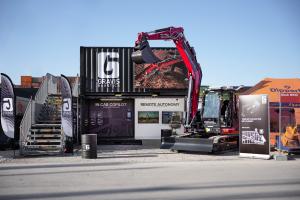Gravis Robotics Launches 'Anywhere Autonomy' at Bauma 2025
At Bauma 2025, Gravis Robotics unveils its earthmoving autonomy platform, transforming standard heavy equipment into robotic teammates.
By retrofitting onto existing machines such as excavators and wheel loaders, Gravis empowers project teams to excavate, load, and manage material with unprecedented precision and throughput— enhancing productivity with up to 30% faster performance in high-volume tasks. Gravis uses advanced AI to deliver higher fill rates per bucket and efficient cycle times during autonomous excavation tasks. The system “feels” and adapts to changing ground conditions, maximizing productivity even in hard and inconsistent soil.
Whether loading trucks in a quarry, trenching utilities for new development, or bulk-excavating for road construction, the platform’s advanced situational awareness and user-centric design make heavy machinery both highly efficient and remarkably easy to control.
At the heart of the system is the Gravis Rack: a rooftop-mounted autonomous control kit that layers real-time 3D surveying, visual situational awareness, geospatial positioning, and performance-focused AI onto the machines you already use. It pairs with the Gravis Slate, a rugged touchscreen interface that makes getting started with autonomy as simple as tapping a finger.
“With global labor shortages in construction and a rising demand for critical infrastructure, the industry needs to focus on productivity as the core driver for automation,” said Ryan Luke Johns, CEO of Gravis Robotics. “The industry needs better tools to help operators dig faster, safer, and with less rework—and to help attract, upskill, and retain the next generation of operators.” Gravis makes autonomy feel like adaptive cruise control: practical, powerful, and ready today.
Anywhere Autonomy
Gravis makes it easy for crews to use autonomy—no matter their experience level. Whether you're in the cab, outside, or remote, the system fits right in. Using the Gravis Slate, operators can choose how much control they want: from helpful AR guidance that replaces conventional machine control to setting up an autonomous task with a tap from afar. By sidestepping the usual integration headaches of construction tech, contractors can start simple and scale autonomy at their own pace. The result: less fatigue, better accuracy, and faster digging—especially on tough, repetitive jobs.
Pricing and Subscription Model
The Gravis system is available as a one-time hardware upgrade (including installation), plus an annual software license for autonomy and analytics. Leasing options are available, and every proposal includes tailored ROI modeling based on your fleet and project needs.
Live at Bauma
Alongside the product launch at Bauma, Gravis has emerged with a number of significant OEM collaborations—with CASE, Develon, Hitachi, Menzi Muck, Sumitomo, and Yanmar revealing their relationships with Gravis Robotics at the show.
Gravis is featured in several live demonstrations, happening several times daily at Develon (autonomous truck loading), Hitachi (autonomous trenching), and Menzi Muck (augmented teleoperation).
Visitors can experience remote autonomy in action—controlling machines 200 kilometers away in Zürich—during daily demos at 1:30 PM at the Gravis booth.
About Gravis Robotics
Gravis Robotics delivers next-generation earthmoving autonomy that boosts jobsite performance. By combining AI, machine vision, and human-first interfaces, Gravis helps contractors increase throughput, reduce waste, and enhance job site safety—whether they’re in the cab or coordinating work remotely.
Media Contact
Name: Sheila Bugal
Title: Marketing Manager
Email: sbugal@gravisrobotics.com
Phone: +41 44 442 07 70
Website: www.gravisrobotics.com
HQ Address: Thurgauerstrasse 66, 8050 Zürich, Switzerland
Press Kit
For interviews, images, or more information, please contact Sheila Bugal at sbugal@gravisrobotics.com.
Sheila Bugal
Gravis Robotics
+41 44 442 07 70
sbugal@gravisrobotics.com
Visit us on social media:
Facebook
X
LinkedIn
Instagram
YouTube
TikTok
Legal Disclaimer:
EIN Presswire provides this news content "as is" without warranty of any kind. We do not accept any responsibility or liability for the accuracy, content, images, videos, licenses, completeness, legality, or reliability of the information contained in this article. If you have any complaints or copyright issues related to this article, kindly contact the author above.
12-Year-Old Author Eliana Fernández Launches Your 12 Superpowers on Her Birthday
Conditsis Lawyers Wins National and Local Awards for Outstanding Legal Services
Rising Energy Demand and Infrastructure Projects Fuel Cable Glands Market Expansion
Więcej ważnych informacji
 Jedynka Newserii
Jedynka Newserii

 Jedynka Newserii
Jedynka Newserii

Prawo

Kolejne polskie miasta chcą być przyjazne dzieciom. Planują stworzyć najmłodszym dobre warunki do rozwoju
Cztery miasta w Polsce posiadają tytuł Miasta Przyjaznego Dzieciom nadany przez UNICEF Polska. Dziewięć kolejnych miast czeka na certyfikację, a w ostatnich miesiącach do programu zgłosiło się kilka następnych. Na całym świecie inicjatywa została przyjęta już w ponad 4 tys. samorządów, a w Hiszpanii objęła połowę dziecięcej populacji miast. Program UNICEF-u ma na celu zachęcenie włodarzy do traktowania najmłodszych obywateli w sposób podmiotowy, respektowania ich praw i zaproszenia ich do współdecydowania o przyszłości.
Przemysł
W ciągu roku w Polsce ubyło 500 przedsiębiorstw odzieżowo-tekstylnych. Problemem są spadki zamówień z Europy Zachodniej i wzrost kosztów

Wartość rynku odzieżowego w Polsce wynosi 66,9 mld zł, z czego 10 mld zł to wartość krajowej produkcji – wynika z danych PIOT. Od czasu pandemii branża mierzy się z szeregiem wyzwań, wśród których najpoważniejsze to wzrost kosztów pracy i produkcji, przerwane łańcuchy dostaw i spadek zamówień – zarówno w kraju, jak i za granicą, a także wzrost nieuczciwej konkurencji na rynku, czyli głównie importu z Chin. Skala wyzwań sprawia, że w ubiegłym roku z rynku zniknęło 500 firm. Producenci odzieży apelują do rządu o wsparcie.
Handel
D. Obajtek: Orlen powinien być o 30–40 proc. większą spółką. Byłoby to z korzyścią dla konsumentów

Orlen jest największym polskim przedsiębiorstwem. Jego przychody ze sprzedaży w 2024 roku wyniosły blisko 295 mln zł, a rok wcześniej – ponad 372 mln – wynika z raportu Rzeczpospolitej „Lista 500”. W ubiegłorocznym rankingu Fortune 500 uwzględniającym największe korporacje znalazł się na 216. miejscu na świecie i 44. w Europie. Według Daniela Obajtka, europosła PiS-u i byłego prezesa Orlenu, spółka powinna jeszcze urosnąć, tym samym gwarantując konsumentom szereg korzyści, a także przyspieszać inwestycje m.in. w obszarze petrochemii i energetyki zero- oraz niskoemisyjnej.
Partner serwisu
Szkolenia

Akademia Newserii
Akademia Newserii to projekt, w ramach którego najlepsi polscy dziennikarze biznesowi, giełdowi oraz lifestylowi, a także szkoleniowcy z wieloletnim doświadczeniem dzielą się swoją wiedzą nt. pracy z mediami.








.gif)

 |
| |
| |
|